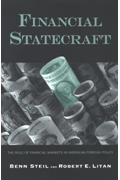As trade flows expanded and trade agreements proliferated after World War II, governments—most notably the United States—came increasingly to use their power over imports and exports to influence the behavior of other countries. But trade is not the only way in which nations interact economically. Over the past two decades, another form of economic exchange has risen to a level of vastly greater significance and political concern: the purchase and sale of financial assets across borders. Nearly $2 trillion worth of currency now moves cross-border every day, roughly 90 percent of which is accounted for by financial flows unrelated to trade in goods and services—a stunning inversion of the figures in 1970. The time is ripe to ask fundamental questions about what Benn Steil and Robert Litan have coined as “financial statecraft,” or those aspects of economic statecraft directed at influencing international capital flows. How precisely has the American government practiced financial statecraft? How effective have these efforts been? And how can they be made more effective? The authors provide penetrating and incisive answers in this timely and stimulating book.
“What makes Financial Statecraft particularly useful for non-economists and policymakers, as well as Wall Street executives and historians alike, is the authors’ willingness to be prescriptive about finance in public policy. . . . This is a useful, accessible book for lay readers seeking an understanding of the important role that capital flows play in the making of foreign policy.” —Economist
“Scholarly treatment of financial statecraft has been meager, but this book is a major first step. . . . Policymakers, researchers, and global executives will come away from this book with a new perspective on the economics of foreign policy in the modern world.” —Sean Silverthorne, Harvard Business School Working Knowledge
Authors

